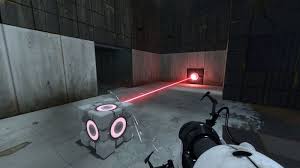Portal 2 is a puzzle game made by Valve, and a sequel to their hit game Portal. The game has been released for computers and most major consoles. I played it on my Xbox One. Portal 2 includes some timing puzzles, which can be difficult for players inexperienced with movement in 3d games. Additionally, the game includes scenes that might be scary for younger players. Therefore, it is best suited for young adult players and older with experience playing 3d games. For this critical play, I was interested in uncovering how a game consisting entirely of puzzles tells an engaging story. I discovered that Portal 2 uses its puzzle mechanics to create an emergent narrative that gets players invested in its story of fighting an evil supercomputer.
Because I’ve played Portal 2 before, I tried to put a designer’s lens on my experience to uncover details I missed in my previous playthroughs. This time around it jumped out at me that, in the first act, the story is delivered to the player primarily by having puzzle mechanics break. Portal uses an architecture that Daniel Cook calls micro parallel arcs, in which interaction arcs delivering story events are woven throughout the gameplay. Interaction arcs progress in several steps: (1) the player uses their mental model of the game system to make a prediction about the game, (2) the player acts on the system to produce a desired outcome, (3) the game system processes the player’s action using its rule set, and (4) the player receives feedback. In the case of Portal 2, the player develops a mental model of puzzle elements from the main gameplay loop, but then the game changes its rules set to subvert the player’s expectations. For example, the game introduces cubes that the player uses throughout the game to solve puzzles. The player develops the mental model that when they press the “action” button on their gamepad or keyboard while facing a cube, their character will pick up the cube. However, in Test Chamber 7, the player picking up the chamber’s cube triggers it to disintegrate. This is a subversion of the player’s mental mode; The rules of the game have changed. Then, the player receives feedback from the game: GLaDOS, the player’s evil-supercomputer-antagonist and narrator for the first few chapters, comments sarcastically, “Oh, did I accidentally fizzle that before you could complete the test? I’m sorry”. This interaction arc develops GLaDOS’s character as needlessly petty and cruel, and it occurs through breaking the puzzle mechanics.
Interaction arcs that break the puzzle mechanics occur throughout the first act of Portal 2, and the cumulative effect is an emergent narrative in which the player imagines themself as rebelling against GLaDOS. In the above example from Test Chamber 7, GLaDOS frustrates the player by interrupting the gameplay loop. The whole arc then repeats: GLaDOS drops another cube, and the player picks it up and tries to use it to block the path of a laser. Then, GLaDOS disintegrates the cube again, remarking “Oh, no. I fizzled that one too,” sounding maddeningly pleased with herself. The player is then allowed to proceed through the rest of the test, at the end of which they’re presented with a broken emancipation grill. GLaDOS tells the player that these emancipation grills are placed at the end of Test Chambers to prevent test subjects from taking testing objects with them. “Don’t take anything with you,” she tells the player, sternly. (Note that the player walks through emancipation grills at the end of every previous Test Chamber. Again here we see puzzle mechanics being broken to present interaction arcs.) At this point, the player is presented with the opportunity for retribution against GLaDOS for frustrating them earlier. Retribution is a huge incentive for players as it allows them to reassert their agency against an antagonist. The player is incentivized to backtrack and grab the cube from earlier in the level to bring it with them out of the Test Chamber. In response to the player’s act of spite, GLaDOS again asserts her own agency over the player. As the player reaches the elevator to the next level, the doors to Test Chamber 7 locked behind them, the GLaDOS fizzles the cube one last time, mocking the player once more: “I think that one was about to say ‘I love you’”. This cat-and-mouse dynamic between the player and GLaDOS creates a powerful emergent narrative in which the player genuinely wants to defeat GLaDOS. As act 1 progresses, the player is promised the opportunity to do just that, and so they’re motivated to continue through Test Chambers by the hope of triumph over the evil robot who torments them. Portal 2’s puzzle mechanics create an emergent narrative that gets players invested in its story and world.



